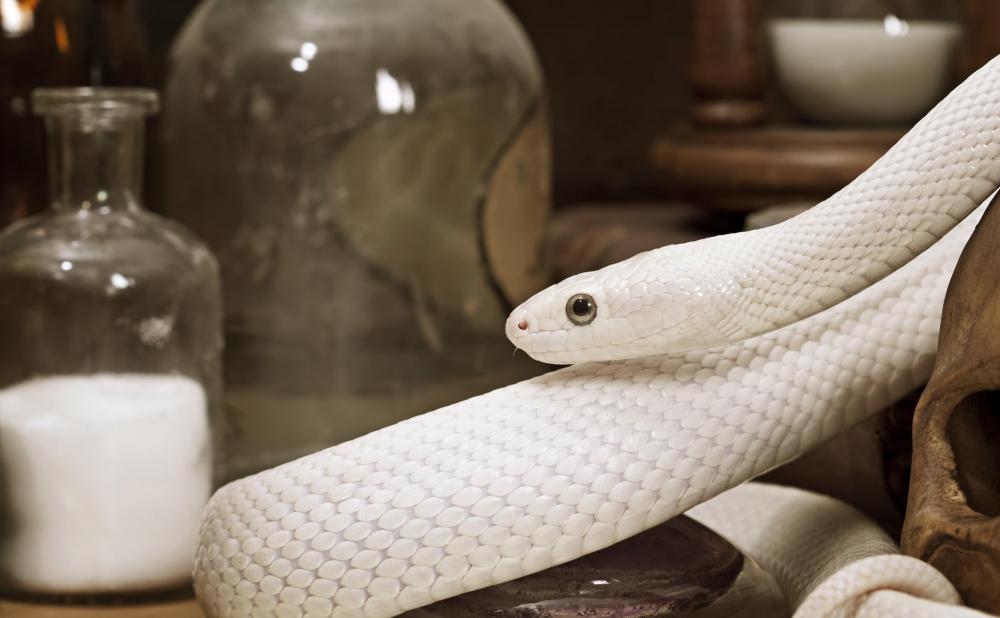At AllThingsNature, we're committed to delivering accurate, trustworthy information. Our expert-authored content is rigorously fact-checked and sourced from credible authorities. Discover how we uphold the highest standards in providing you with reliable knowledge.
What Is an Albino Kingsnake?
An albino kingsnake generally refers to a California kingsnake which has a genetic mutation preventing its exterior from producing melanin. This prevents the typical dark colors in most kingsnakes from appearing, giving the albino kingsnake a light appearance. Unlike certain other albino species, namely mammals, it does not appear totally white but is more of a pale yellow color with white stripes. They are often kept and bred as pets.
The albino kingsnake occurs naturally in the wild on rare occasions, but they do not typically survive well into adulthood. This is because most kingsnakes rely on their coloring to effectively camouflage them from predators, as well as to keep them hidden from prey during hunting. The light yellow coloring of the albino snakes make the juveniles an easy target for hungry birds and mammals looking for a meal.

In captivity, however, the albino kingsnake has become a widely sought pet. They are bred specifically to produce more snakes with this mutation. Albino snakes are sometimes harder to find than normal kingsnakes, and thus, they may cost more money to purchase. Many pet stores carry them, or they can be bought from reputable breeders.
The albino kingsnake, as well as other kingsnakes, are relatively docile in nature. They generally respond well to frequent handling by humans and generally do not bite unless provoked. Kingsnakes usually grow to be between two and four feet (0.61to 1.22 meters) long. Most times they are relatively easy to care for because they are generally low maintenance when compared to other pets.

Kingsnakes require a secure cage so that they cannot escape, as well as a box or artificial cave where they can hide during the day. The cage will need to be cleaned regularly to ensure that fecal matter and other materials are properly removed for the health of the animal. Kingsnakes eat rodents, like small mice, as well as birds and even other snakes. Most kingsnakes need to be fed at least once per week, although instructions may be given by the breeder on proper feeding or books can be purchased on snake care.
The albino kingsnake typically breeds easily and readily in captivity. They are usually between two and three years of age when breeding behavior begins, and six or more offspring may result each time. Selling kingnakes may be profitable, but it is important that breeders act ethically by ensuring the health of all offspring and parent snakes as well as by obtaining any necessary legal licensing if applicable.
Frequently Asked Questions
What is an albino kingsnake?
An albino kingsnake is a genetic variant of the common kingsnake that lacks melanin, the pigment responsible for coloration in animals. This results in a distinctive appearance featuring white or pink skin with bright red or yellow patterns. They are popular in the pet trade due to their unique and striking appearance.
How does albinism affect a kingsnake's behavior and lifespan?
Albinism does not typically affect a kingsnake's behavior. However, albino kingsnakes may be more sensitive to light due to the lack of pigment in their eyes. In captivity, with proper care, their lifespan is comparable to normal kingsnakes, often living up to 20 years or more, according to herpetological societies.
Are albino kingsnakes rare in the wild?
Albino kingsnakes are indeed rare in the wild. Their bright coloration makes them more susceptible to predators, as they lack the natural camouflage that helps protect their non-albino counterparts. Consequently, they have lower survival rates, which contributes to their rarity in natural habitats.
Can albino kingsnakes produce normal-colored offspring?
Yes, albino kingsnakes can produce normal-colored offspring if they carry the recessive gene for albinism and mate with a partner that has dominant genes for normal coloration. The offspring's appearance will depend on the genetic combination inherited from both parents.
What special care do albino kingsnakes require as pets?
Albino kingsnakes require similar care to other kingsnake varieties, with some additional considerations. They need protection from excessive light and should be provided with ample shade in their enclosures. Their habitat should be kept at appropriate temperatures and humidity levels, and they should be fed a diet of appropriately sized rodents.
Is it ethical to breed albino kingsnakes?
The ethics of breeding albino kingsnakes, like any animal breeding, is subject to debate. Some argue that breeding for specific traits like albinism can perpetuate health issues. Responsible breeders focus on the well-being of the animals, avoiding inbreeding and ensuring genetic diversity to maintain healthy populations.
AS FEATURED ON:
AS FEATURED ON:












Discuss this Article
Post your comments